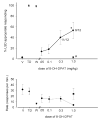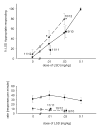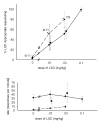The 5-HT1A receptor and the stimulus effects of LSD in the rat
- PMID: 16025319
- PMCID: PMC1266303
- DOI: 10.1007/s00213-005-0068-6
The 5-HT1A receptor and the stimulus effects of LSD in the rat
Abstract
Rationale: It has been suggested that the 5-HT1A receptor plays a significant modulatory role in the stimulus effects of the indoleamine hallucinogen lysergic acid diethylamide (LSD).
Objective: The present study sought to characterize the effects of several compounds with known affinity for the 5-HT1A receptor on the discriminative stimulus effects of LSD.
Methods: Twelve male Fischer 344 rats were trained in a two-lever, fixed-ratio (FR) 10, and food-reinforced task with LSD (0.1 mg/kg, i.p.; 15-min pretreatment) as a discriminative stimulus. Combination and substitution tests with the 5-HT(1A) agonists, 8-OH-DPAT, buspirone, gepirone, and ipsapirone, with LSD-induced stimulus control were then performed. The effects of these 5-HT1A ligands were also tested in the presence of the selective 5-HT1A receptor antagonist, WAY-100,635 (0.3 mg/kg, s.c.; 30-min pretreatment).
Results: In combination tests, stimulus control by LSD was increased by all 5-HT1A receptor ligands with agonist properties. Similarly, in tests of antagonism, the increase in drug-appropriate responding caused by stimulation of the 5-HT1A receptor was abolished by administration of WAY-100,635.
Conclusion: These data, obtained using a drug discrimination model of the hallucinogenic effects of LSD, provide support for the hypothesis that the 5-HT1A receptor has a significant modulatory role in the stimulus effects of LSD.
Figures





Similar articles
-
Dopamine D4 receptor involvement in the discriminative stimulus effects in rats of LSD, but not the phenethylamine hallucinogen DOI.Psychopharmacology (Berl). 2009 Apr;203(2):265-77. doi: 10.1007/s00213-008-1238-0. Epub 2008 Jul 6. Psychopharmacology (Berl). 2009. PMID: 18604600
-
The stimulus effects of 8-OH-DPAT: evidence for a 5-HT2A receptor-mediated component.Pharmacol Biochem Behav. 2008 Jan;88(3):312-7. doi: 10.1016/j.pbb.2007.09.011. Epub 2007 Sep 19. Pharmacol Biochem Behav. 2008. PMID: 17936346 Free PMC article.
-
Discriminative stimulus properties of the 5-HT1A receptor biased agonists NLX-101 and F13714, in rats trained to discriminate 8-OH-DPAT from saline.Behav Pharmacol. 2021 Dec 1;32(8):652-659. doi: 10.1097/FBP.0000000000000659. Behav Pharmacol. 2021. PMID: 34751175 Free PMC article.
-
The putative 5-HT1A receptor antagonist DU125530 blocks the discriminative stimulus of the 5-HT1A receptor agonist flesinoxan in pigeons.Eur J Pharmacol. 1997 May 1;325(2-3):145-53. doi: 10.1016/s0014-2999(97)00131-3. Eur J Pharmacol. 1997. PMID: 9163561
-
Complex discriminative stimulus properties of (+)lysergic acid diethylamide (LSD) in C57Bl/6J mice.Psychopharmacology (Berl). 2005 Jun;179(4):854-62. doi: 10.1007/s00213-004-2108-z. Epub 2005 Jan 12. Psychopharmacology (Berl). 2005. PMID: 15645221
Cited by
-
Differential effects of serotonin 5-HT1A receptor agonists on the discriminative stimulus effects of the 5-HT2A receptor agonist 1-(2,5-dimethoxy-4-methylphenyl)-2-aminopropane in rats and rhesus monkeys.J Pharmacol Exp Ther. 2010 Apr;333(1):244-52. doi: 10.1124/jpet.109.163451. Epub 2010 Jan 6. J Pharmacol Exp Ther. 2010. PMID: 20053932 Free PMC article.
-
Psychedelics.Pharmacol Rev. 2016 Apr;68(2):264-355. doi: 10.1124/pr.115.011478. Pharmacol Rev. 2016. PMID: 26841800 Free PMC article. Review.
-
Recent advances in the neuropsychopharmacology of serotonergic hallucinogens.Behav Brain Res. 2015 Jan 15;277:99-120. doi: 10.1016/j.bbr.2014.07.016. Epub 2014 Jul 15. Behav Brain Res. 2015. PMID: 25036425 Free PMC article. Review.
-
A Single Administration of Psilocybin Persistently Rescues Cognitive Deficits Caused by Adolescent Chronic Restraint Stress Without Long-Term Changes in Synaptic Protein Gene Expression in a Rat Experimental System with Translational Relevance to Depression.Psychedelic Med (New Rochelle). 2023 Mar 13;1(1):54-67. doi: 10.1089/psymed.2022.0012. eCollection 2023 Mar. Psychedelic Med (New Rochelle). 2023. PMID: 40047006 Free PMC article.
-
Dopamine D4 receptor involvement in the discriminative stimulus effects in rats of LSD, but not the phenethylamine hallucinogen DOI.Psychopharmacology (Berl). 2009 Apr;203(2):265-77. doi: 10.1007/s00213-008-1238-0. Epub 2008 Jul 6. Psychopharmacology (Berl). 2009. PMID: 18604600
References
-
- Aghajanian GK, Foote WE, Sheard MH. Lysergic acid diethylamide:sensitive neuronal units in the midbrain raphe. Science. 1968;161:706–708. - PubMed
-
- Aghajanian GK, Haigler HJ. Hallucinogenic indoleamines: preferential action upon presynaptic serotonin. Psychopharmacol Commun. 1975;1:619–629. - PubMed
-
- Arnt J, Hyttel J. Facilitation of 8-OH-DPAT-induced forepaw treading of rats by the 5-HT2 agonist DOI. Eur J Pharmacol. 1989;161:45–51. - PubMed
-
- Arvanov VL, Liang X, Russo A, Wang RY. LSD and DOB: interaction with 5-HT2A receptors to inhibit NMDA receptor-mediated transmission in the rat prefrontal cortex. Eur J Neurosci. 1999;11:3064–3072. - PubMed
-
- Blier P, Lista A, deMontigny C. Differential properties of pre- and postsynaptic 5-hydroxytryptamine1A receptors: II. Effect of pertussis and cholera toxins. J Pharmacol and Exp Ther. 1993;265:6–23. - PubMed
Publication types
MeSH terms
Substances
Grants and funding
LinkOut - more resources
Full Text Sources

